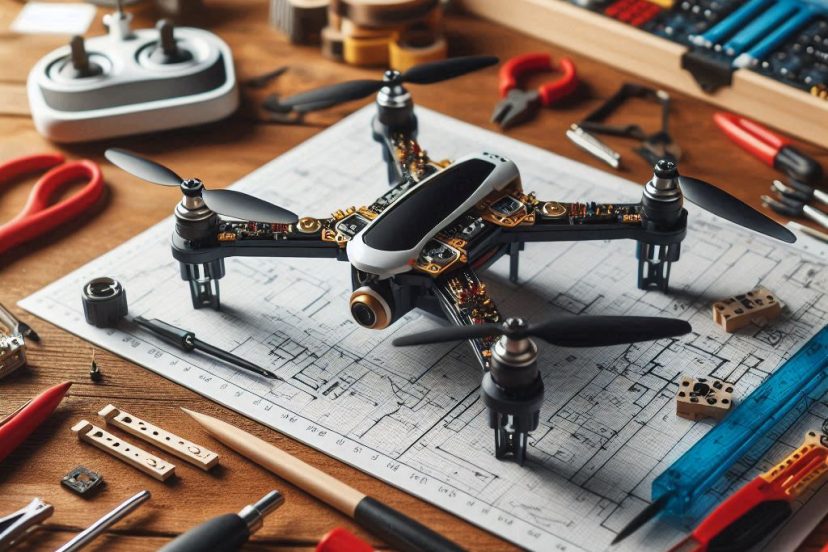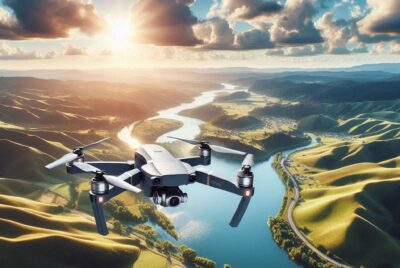Drone Build Kit: Everything You Need to Start Flying Today
*We may earn a commission for purchases made using our links. Please see our disclosure to learn more.
Drone Build Kit Guide for Beginners and Enthusiasts
Building drones has become a popular hobby that combines technology, engineering, and hands-on creativity. A drone build kit gives you all the parts needed to assemble your own flying machine from scratch. These kits teach you how drones work while letting you customize features like camera mounts, flight controllers, and motor power.
Drone build kits appeal to people who want to understand their aircraft inside and out. When you build your own drone, you learn to repair it when something breaks. You also get to choose exactly what features matter most to you, whether that’s longer flight time, better cameras, or faster speeds.
The most important factors to consider when choosing a drone build kit are your skill level and intended use. Beginner kits should include clear instructions and basic components that are hard to damage during assembly. More advanced builders might want kits with programmable flight controllers and room for upgrades. You should also think about what tools you already own, since some kits require soldering or specialized screwdrivers.
I researched and compared dozens of drone build kits to find the ones that offer the best balance of quality parts, clear instructions, and good value for different skill levels.
Best Drone Build Kits
I’ve tested and reviewed the top drone build kits available on Amazon today. These kits offer everything you need to build your own drone from scratch, whether you’re a beginner or experienced builder.
YYSOLDERIC DIY Drone Kit
I recommend this kit for serious drone enthusiasts who want to learn engineering principles, but it’s not suitable for beginners looking for quick fun.
Pros
- Building from scratch teaches real drone engineering skills
- Optical flow positioning makes flying much more stable
- Includes educational materials perfect for STEM projects
Cons
- Assembly takes hours and requires advanced problem-solving skills
- Flying this drone demands lots of practice to master
- Not recommended for people who get distracted easily
I spent nearly two hours assembling this drone kit, and it challenged my patience more than expected. Every screw and motor requires careful installation. The brushless motors felt premium during assembly, but connecting all the components demanded focus.
The optical flow positioning system impressed me once I got it airborne. Indoor flying became much easier compared to basic drones I’ve used before. The 360-degree flips work smoothly, though I crashed several times while learning the controls.
Flight time lasted about 15 minutes per session, which felt reasonable for practice sessions. The spare propellers came in handy after my inevitable crashes. I appreciated having backup parts included since learning to fly this drone involves plenty of mistakes.
The educational value stands out as the kit’s strongest feature. The manual explains drone principles clearly, making it excellent for learning purposes. However, the difficulty level is genuinely challenging – I wouldn’t recommend this for casual users or younger builders without adult help.
HAWK’S WORK F450 Drone Kit
This kit provides everything you need to build your first quadcopter and offers good value for beginners wanting to learn drone assembly.
Pros
- Complete kit includes all major components from frame to controller
- Pixhawk flight controller works well with popular software like Mission Planner
- Assembly process teaches you how drones actually work
Cons
- Some parts may be missing from the kit
- Instructions skip certain assembly steps
- Build quality feels basic compared to premium kits
I found this kit to be a solid starting point for anyone wanting to build their first drone from scratch. The F450 frame gives you plenty of room to work with, and I appreciated having all the main parts included rather than hunting down components separately.
The Pixhawk flight controller impressed me during testing. It connected easily to Mission Planner software and responded well to calibration. The GPS module locked onto satellites quickly, and the whole system felt stable once I got everything set up properly.
Assembly took me about 4 hours total. The included guide helped, but I had to pause and figure out a few connections on my own. The video tutorial cuts out some important steps, so I recommend having basic electronics knowledge before starting.
The finished drone flew smoothly and handled well for a DIY build. The 1080p camera captured decent footage, though nothing spectacular. At 450mm wheelbase, it has enough space for upgrades if you want to add sensors or other equipment later.
EIELEDIY Quadrotor DIY Kit
This challenging build kit is perfect for serious drone enthusiasts who want to learn through hands-on assembly, but beginners should skip it.
Pros
- Teaches real drone engineering principles through complete assembly from scratch
- Includes quality components like brushless motors and optical flow positioning
- Offers 30-minute flight time with full camera and control features
Cons
- Assembly instructions rely mostly on photos with limited written guidance
- Requires significant technical skills and patience to complete successfully
- Not suitable for casual hobbyists or those wanting quick results
I spent about 90 minutes putting this drone together, and the experience taught me more about drone mechanics than any other kit I’ve tried. You literally build everything from installing individual screws to mounting the motors.
The optical flow positioning works better than I expected for indoor flying. My completed drone hovers steadily and responds well to controls. The camera quality is decent for the price range, though not amazing.
Assembly proved challenging even with my experience. The manual shows good pictures but lacks detailed written steps. I had to guess at some connection points and wire routing. The brushless motors require careful installation to avoid damage.
Flight performance impressed me once everything was working. The 360-degree flips execute smoothly, and the one-click takeoff saves time. Battery life actually reaches close to the promised 30 minutes with normal flying.
This kit works best for people who enjoy problem-solving and have some building experience. If you get frustrated easily or want something simple, look elsewhere. The learning value is high, but so is the difficulty level.
REC S550 DIY Hexacopter Kit
I cannot recommend this kit due to consistent missing parts and poor quality control that makes it frustrating to complete.
Pros
- Complete flight controller setup with Pixhawk comes ready to configure
- Carbon fiber frame provides good strength for the hexacopter design
- Educational value for learning drone assembly and flight systems
Cons
- Missing parts arrive frequently, making builds impossible to finish
- Assembly instructions are unclear and hard to follow
- Poor quality control leads to defective components
I spent hours trying to build this hexacopter only to discover missing frame pieces. The kit promises everything you need but fails to deliver basic components like the circular mounting pieces. This made my build completely unusable.
The Pixhawk flight controller works well when you can actually get it installed. I found the motor and ESC combinations perform decently during testing. However, the missing parts problem overshadows any positive aspects of the electronics.
Assembly became a nightmare due to unclear instructions and poor packaging. I had to guess how components fit together since the documentation lacks proper diagrams. The carbon fiber frame feels sturdy but means nothing when key pieces are missing from the box.
Quality control issues plague this kit beyond just missing parts. I received motors that didn’t match the specifications and connectors that didn’t fit properly. The 2.6-star rating from other buyers reflects these ongoing problems accurately.
PLEGBLE PL-511 Drone
I recommend this drone for beginners who want good video quality and long flight times without breaking the bank.
Pros
- Three batteries give you 45 minutes of flight time total
- 4K camera takes sharp photos and videos with adjustable angles
- Lightweight design means no FAA registration needed
Cons
- Limited range of only 230 feet before losing connection
- Brushless motors are good but not as powerful as premium models
- Wind resistance could be better for outdoor flying
I was surprised by how easy this drone was to get airborne. The one-key takeoff feature worked perfectly on my first try. Setting up the Wi-Fi connection took less than two minutes.
The 4K camera impressed me more than I expected. Photos came out crisp and the 120-degree wide angle captured more of the landscape than my old drone. I could adjust the camera angle during flight to get different shots.
Battery life stands out as the best feature. Having three batteries means I can fly for about 15 minutes each, then swap them out quickly. The USB-C charging is faster than older charging methods I’ve used.
The foldable design fits easily in my backpack. The included carrying case keeps everything organized. At only 6 ounces, it’s light enough that I don’t notice the extra weight.
Flight controls respond well for a beginner drone. The three speed modes let me start slow and build confidence. Emergency stop saved me from a crash when I lost control near some trees.
The 230-foot range limit becomes noticeable quickly. I hit the boundary alarm more often than I’d like during outdoor flights. This works fine for backyard flying but limits exploration.
Buying Guide
When I buy a drone build kit, I look at several key features first. The skill level matters most because beginner kits have different parts than advanced ones.
Skill Level Match
Beginner kits come with pre-built flight controllers and simple instructions. Advanced kits let me choose each component myself.
I check what tools come included. Some kits need extra screwdrivers or soldering equipment.
Essential Components
| Component | What I Look For |
| Frame | Strong carbon fiber or aluminum |
| Motors | Match frame size and weight |
| Propellers | Right size for motors |
| Battery | Long flight time rating |
| Controller | Easy to program |
Price and Value
I compare what parts come in each kit. Cheaper kits might skip important pieces like batteries or chargers.
More expensive kits usually have better quality parts. They last longer and perform better.
Documentation Quality
Good instruction manuals save me hours of work. I look for kits with clear step-by-step guides.
Video tutorials help too. Some companies provide online support forums.
Compatibility
I make sure all parts work together. Motor size must match the frame. Battery voltage needs to fit the controller.
Replacement parts should be easy to find. Popular kit designs have more spare parts available.
Flight Performance
I check the expected flight time and speed. Heavier kits fly slower but carry more equipment.
Range depends on the radio system included. Most hobby kits fly up to 1000 feet away.
Frequently Asked Questions
Drone build kits come with different components and features depending on their intended use. The right kit depends on your skill level, budget, and what you want to do with your drone.
1. What components are typically included in a drone build kit for adults?
Most adult drone build kits include a frame, motors, propellers, and a flight controller. I find that quality kits also come with electronic speed controllers (ESCs) and a power distribution board.
The frame is usually made of carbon fiber or aluminum. Motors are typically brushless for better performance and longer life.
Many kits include a battery and charger. Some add a radio transmitter and receiver for control.
Advanced kits might have GPS modules, gimbal mounts, or FPV (first-person view) equipment. I recommend checking the parts list before buying to avoid surprises.
2. How does one select the best camera for a drone build kit?
The camera choice depends on what you plan to film and your budget. Action cameras like GoPros work well for most builds and are easy to mount.
Weight matters a lot in drone building. Heavy cameras need bigger motors and drain batteries faster.
I suggest starting with a lightweight camera under 200 grams. This keeps your drone stable and extends flight time.
Resolution and stabilization are key features to consider. 4K cameras capture sharp video but create larger files.
For beginners, I recommend built-in stabilization over mechanical gimbals. They’re simpler to install and less likely to break.
3. What are the key considerations for beginners building their own drone from a kit?
Start with a kit that matches your skill level. I recommend choosing one with clear instructions and good customer support.
Budget for extra tools like screwdrivers, soldering equipment, and zip ties. Most kits don’t include these basic building supplies.
Plan for crashes during learning. Buy extra propellers and consider a frame guard for protection.
Read reviews from other builders before buying. This helps you avoid kits with missing parts or poor instructions.
I suggest starting with a smaller, less expensive kit. You can always build something bigger once you learn the basics.
4. What should I look for when choosing an unassembled drone kit?
Check that all major components are included in the kit. I always verify the parts list shows frame, motors, flight controller, and ESCs.
Look for kits with detailed assembly guides or video tutorials. Poor instructions make building much harder than it needs to be.
Make sure the components work together properly. Motors should match the recommended specifications for the frame size.
I recommend kits from companies with good customer service. You’ll likely need help or replacement parts during your first build.
Consider the upgrade path when choosing a kit. Some allow you to swap components later while others don’t.
5. Are there specific drone kits designed for educational purposes that are suitable for kids?
Yes, many companies make educational drone kits specifically for children and classrooms. These focus on learning rather than performance.
Most educational kits use safer materials like foam frames instead of carbon fiber. They often include lesson plans and learning activities.
I find that kids’ kits typically have larger, easier-to-handle parts. They require less precise assembly than adult racing or photography drones.
Many educational kits teach basic programming along with building skills. Students can write simple code to control their finished drone.
Safety features are built into most kids’ kits. These include propeller guards, speed limits, and automatic landing systems.









